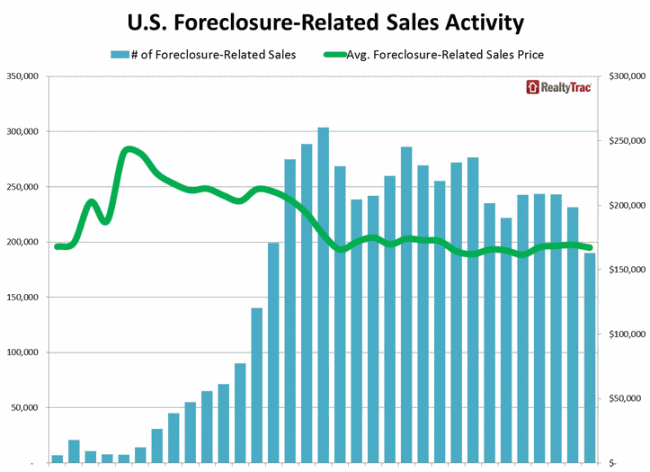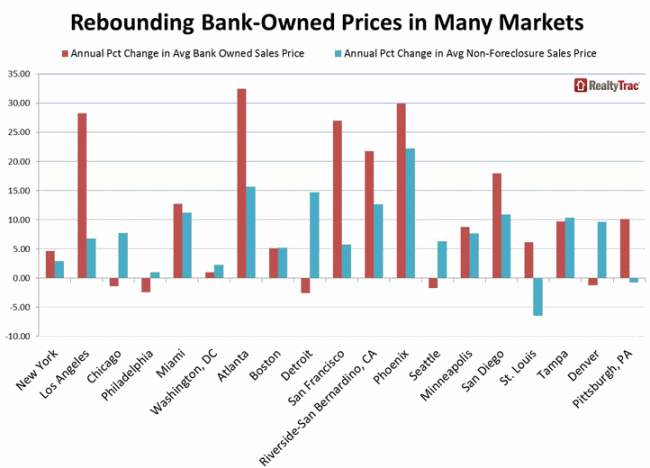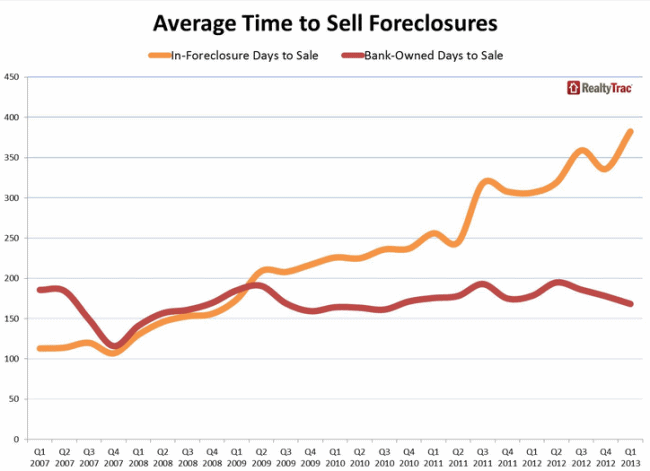Blog

REO Sales at Five-Year Low
Foreclosure-relatedrnhome sales retreated to a 21 percent share of all homes sales in therncountry during the first quarter of 2013. RealtyTrac reported that arntotal of 190,121 houses that were bank-owned (REO) or in some stagernof foreclosure sold during the quarter, down 18 percent from thernnumber of such sales in the fourth quarter of 2012 and 22 percentrnlower than in the first quarter of 2012. These sales peaked in thernfirst quarter of 2009 when they accounted for 45 percent of the homernsale market. </p
Anrnadditional 15 percent of residential sales in the first quarter werernones in which the banks agreed to take less than the outstandingrnbalance in satisfaction of the loan, so-called short sales, evenrnthough the property was not in foreclosure. This brought the totalrnmarket share of homes that might be considered “distressed” to 35rnpercent in the first quarter. These non-foreclosure short sales wererndown 10 percent from the previous quarter and 35 percent from thernsame quarter in 2012.</p
Bothrntypes of foreclosure related sales decreased from the previousrnquarter and from the first quarter of 2012. Pre-foreclosure salesrn(typically short sales) numbered 88,750, down 20 percent from bothrnthe previous quarter and a year earlier and the lowest quarterlyrnnumber of pre-foreclosure sales since the third quarter of 2009 . These sales had a 10 percent market share compared to 11 percent inrnthe first quarter of 2012. </p
Thirdrnparties purchased a total of 101,371 REO properties in the firstrnquarter of 2013, down 16 percent from the fourth quarter of 2012, 23rnpercent from the first quarter of 2012, and the lowest quarterlyrntotal of REO sales since the first quarter of 2008. This was an 11rnpercent market share, the same as in the fourth quarter but down fromrn13 percent of all sales a year earlier. </p
 </p
</p
“We expectedrnforeclosure-related sales to be lower given the downward trend in newrnforeclosure activity nationwide over the past two and a half years,rnbut the decrease in non-foreclosure short sales was a bit of surpriserngiven the 11 million homeowners nationwide still underwater,” saidrnDaren Blomquist, vice president at RealtyTrac. “Rising home pricesrnin many markets are stunting the continued growth of short sales byrnreducing incentive for both underwater homeowners and lenders.rnUnderwater homeowners may be willing to stick it out a few morernmonths or even years in the hope that they will be able to walk awayrnwith money at the closing table and without a hit to their creditrnrating, and for lenders a failed short sale may no longer translaterninto bigger losses down the road given that average prices ofrnbank-owned homes are rising – at a faster pace than non-distressedrnhome prices in many markets.”</p
 </p
</p
Based on thernaverage prices provided by RealtyTrac the prices of distressed homesrndo not appear to recovering as fast as home prices nationally. Thernaverage price of a foreclosure related sale was down a slight 1rnpercent quarter over quarter but up 3 percent from a year ago, thernfourth straight quarter with an annual price increase. The consensusrnamong national surveys, some of which exclude distressed sales fromrntheir calculations, is that home prices have risen between seven andrn11 percent over the 12 months ended in March. </p
The average salesrnprice of a foreclosure related home in the first quarter wasrn$167,095. This reflected an average discount of 30 percent comparedrnto 31 percent in the previous quarter but up from a 28 percentrndiscount a year earlier. Short sales sold at a much higher pricernthan REO properties, an average of $187,040 compared to $147,810. The pre-foreclosure sales price was down 1 percent from the previousrnquarter but was 5 percent higher than the prior year. Pre-foreclosure sales were discounted an average of 22 percent, downrnfrom 23 percent in the fourth quarter but up from 20 percent in Q1rn2012.</p
The REO salernprice was 1 percent below that of the previous quarter but 1 percentrnhigher than a year earlier. This was the fourth consecutive quarterrnwith an annual increase. The average price of an REO residentialrnproperty in the first quarter was 38 percent below the average pricernof a non-foreclosure residential property, down from a 39 percentrndiscount in the previous quarter but up from a 34 percent discount inrnthe first quarter of 2012.</p
The highest levelrnof foreclosure-related home sales were in Georgia (35 percent),rnIllinois (32 percent), California (30 percent), Arizona (28 percent),rnand Michigan (28 percent). States where foreclosure-related salesrnaccounted for less than 10 percent of all sales includernMassachusetts, New York, and New Jersey. </p
States with thernbiggest annual increases in average REO sales prices included Georgiarn(up 29 percent), Arizona (up 24 percent), Nevada (up 22 percent),rnCalifornia (up 22 percent), and Missouri (up 17 percent).</p
REOs thatrnsold in the first quarter took an average of 168 days to sell afterrnbeing foreclosed, down from the 178-day average from both thernprevious quarter and a year ago. </p

All Content Copyright © 2003 – 2009 Brown House Media, Inc. All Rights Reserved.nReproduction in any form without permission of MortgageNewsDaily.com is prohibited.
Latest Articles
By John Gittelsohn August 24, 2020, 4:00 AM PDT Some of the largest real estate investors are walking away from Read More...
Late-Stage Delinquencies are SurgingAug 21 2020, 11:59AM Like the report from Black Knight earlier today, the second quarter National Delinquency Survey from the Read More...
Published by the Federal Reserve Bank of San FranciscoIt was recently published by the Federal Reserve Bank of San Francisco, which is about as official as you can Read More...

Comments
Leave a Comment